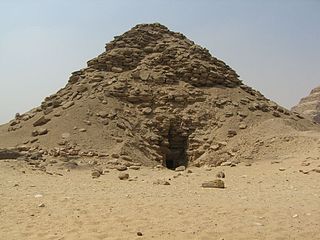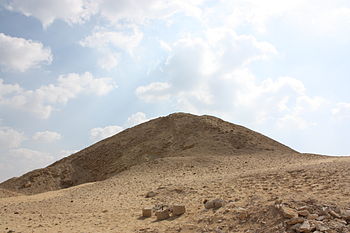 Step pyramid of Djoser | ||
| Saqqara · سقارة | ||
| Governorate | Gīza | |
|---|---|---|
| no tourist info on Wikidata: | ||
| location | ||
| ||
Saqqara, also Saqqara, Arabic:سقارة, Saqqara, in dialect Sa'āra spoken, is a village and an archaeological site in Lower Egypt in the government Gīza. Next to the Gīza pyramid complex this cemetery is one of the most important sites within the Memphite necropolis. It is located about 35 kilometers from the city center Kairos away. The archaeological site is located immediately south of the village of Abū Sīr and three kilometers south of the pyramids of Abū Ṣīr.
background
The important Memphite necropolis used from the 1st dynasty to the Christian era as a burial place for kings and high-ranking private individuals, the north-south extension of the area is 6 km. The part of interest for travelers is to the north of the necropolis.
The earliest mastaba graves date from the 1st Dynasty and are located on the northeastern edge of the necropolis, they are intended for kings and queens. The high point in the history of this necropolis was the construction of the tomb complex of Djoser in the 3rd dynasty. The kings of the 4th and 5th dynasties built their tomb complexes mostly in Giza and Abu Sir. At the end of the Old Kingdom, Saqqara is again the burial place of Egyptian kings (Unas, Userkaf, 5th dynasty; Teti, 6th dynasty). In the following years the necropolis expanded more and more to the south, in the Middle Kingdom the kings were buried in Hawara, Lischt, Lahun and Dahshur. Grave fields of high officials and members of the royal family are grouped around the pyramids.
With the relocation of the imperial capital to Thebes in the New Kingdom, the necropolis loses its importance as a pharaonic burial place; As Memphis continues to be an important administrative center, administrative officials are buried here. The highlight is the end of the 18th dynasty: south of the Unas complex, high-ranking officials, including Maja and Haremhab, have large temple tombs built. The necropolis was also used intensively in the late period.
From the New Kingdom to Roman times, Saqqara has also been the burial place of sacred animals, whose catacomb-like facilities, the Serapeum, are located in the northwest of the necropolis. Mainly the sacred Apis bulls and their mother cows were buried here, but also ibises and baboons.
In Christian times, with the establishment of the Jeremiah Monastery again in importance.
But the outstanding monument is that Step pyramid of Djoser. It is the model for all later pyramids. Starting from the mastaba tomb (Arabic:مسطبة, Masṭaba, „Stone bench, stone platform“), The typical shape of the step pyramid is created through multiple layers. The complex contains other facilities, however, it is surrounded by a huge wall: storage rooms in the west, an altar in the north, a mortuary temple on the north side of the pyramid, palace areas in the east of the pyramid, the great courtyard including the eastern Sedfest courtyard - they serve the ritual acts for the 30-year coronation return (Sedfest) - and the south grave.
getting there
Arrival by public transport

First you take a shared taxi from the bus station behind the Egyptian Museum in the direction of the Giza pyramids ("Haram") and get off at the bus stop for the taxis to Saqqara. Afterwards you get into a shared taxi to Saqqara, but don't get off in Saqqara village! When a sign saying “To Sakkara Antiquities” appears on the right (west) side of the street, get out. Until 1 Ticket booth you have to walk another 1.5 km (20 minutes).
There is no rail connection.
Arrival by taxi
For a one-day trip by taxi from Cairo, you paid LE 400 in September 2015.
mobility
A network of asphalt roads allows easy access to the monuments, but short distances have to be walked. But the entire facility can also be explored on foot. A 1 parking spot is located in the southeast of the Djoser complex immediately in front of its entrance, others in the 2 Near the serapeum and in the 3 Proximity to Ptahhotep's tomb.
Tourist Attractions
Opening times: 9 am–5pm, in winter until 4pm. Admission prices (as of 11/2019):
- Area and Imhotep Museum: LE 200, for students LE 100,
- Combined ticket (area, Imhotep Museum, new graves and graves of the New Kingdom, grave of Mereruka, grave of Mehu, Serapeum): LE 440, for students LE 220,
- Grave of Mereruka: LE 80, for students LE 40,
- Graves on Unas-Aufweg ("Saqqara New Tombs") and temple graves of the New Kingdom (grave of the Haremhab): LE 140, for students LE 70,
- Serapeum: LE 150, for students LE 75,
- Pyramid des Djoser (not in the combination ticket): LE 100, for students LE 50, access is limited to 45 people per day,
- South grave of the Djoser complex (not in the combined ticket): LE 100, for students LE 50,
- Take a taxi with you: LE 5.
All tickets are now being sold at the ticket booth at the entrance. A forgotten ticket is then associated with some walking.
Not all monuments can be visited by the traveler. The mastabas of the 1st Dynasty are among the inaccessible monuments.
Valley temple
- 1 Valley temple of Unas, a few meters from the ticket booth.
museum
 2 Imhotep Museum.
2 Imhotep Museum.
Pyramids


 3 Step pyramid of Djoser. The pyramid complex is accessible, the pyramid itself is not.
3 Step pyramid of Djoser. The pyramid complex is accessible, the pyramid itself is not.
- 4 Pyramid of the Userkaf, Northeast corner of the Djoser complex.
- 5 Pyramid of Teti. Very worthwhile as an alternative to other pyramids, easily accessible and with beautiful pyramid texts.
- The 6 Pyramid of Unas. There is one south of the path to the pyramid 7 Boat pit. Accessible again since May 2016.
- 8 Pyramid of the Sechemchet, inaccessible.
- 9 Gisr el-Mudīr, جسر المدير, Not accessible.
Tombs of private individuals from the Old Kingdom, Teti pyramids complex
The mastaba tombs of the Teti pyramid complex are among the most important private tombs in the Saqqara necropolis:
 10 Mastaba of the Mereruka Meri.
10 Mastaba of the Mereruka Meri.
 11 Mastaba of the Kagemni Memi.
11 Mastaba of the Kagemni Memi.
- The 12 Mastaba of the Ankhmahor Sesi has been accessible to tourists again since May 2016.
Graves of private persons from the Old Kingdom, north of the step pyramid

 13 Mastaba of Ti.
13 Mastaba of Ti.
- 14 Mastaba of Ptahhotep, northwest of the Djoser complex.
- The 15 Serapeum, northwest of the Djoser complex.
Graves of private persons from the Old Kingdom on the Unas-Aufweg
A separate ticket must be purchased for the graves on Unas-Aufweg.
 16 Mastaba of Nianchchnum and Khnumhotep (Zweibrüdergrab).
16 Mastaba of Nianchchnum and Khnumhotep (Zweibrüdergrab).
- 17 Mastaba of Irukaptah, called Chenu, chief of the butchers.
- 18 Mastaba of Neferhor-en-Ptah.
- The 19 Mastaba of the Seshseshet Idut and the two neighboring graves of the 20 Iynefert and des 21 Unas-Ankh Iynefert can be visited free of charge (as of 9/2017).
Temple tombs of the 18th Dynasty
Since May 23, 2011 some temple tombs of the 18th dynasty can be visited. The accessible graves are:
- the 22 Tomb of Maya and Merit
 Tomb of Maya and Merit, Treasurer under Tutankhamun, of particular interest are the underground tombs,
Tomb of Maya and Merit, Treasurer under Tutankhamun, of particular interest are the underground tombs,
 the 23 Haremhab's tomb. It is a dignitary under Ramses II, not the well-known general under Tutankhamun and later king,
the 23 Haremhab's tomb. It is a dignitary under Ramses II, not the well-known general under Tutankhamun and later king,
- the 24 Tomb of Meryneith, Steward and scribe in the temple of Aten under Akhenaten, only from the outside,
- the 25 Tomb of Ptahemwia, royal servant under Akhenaten and Tutankhamun, only from the outside,
- the 26 Tomb of Tia and Tia, Official and overseer of the treasury under Ramses II, only from the outside,
- the 27 Tomb of Pay and Raia, Overseer of the royal harem under Tutankhamun, and that Grave of his son, Raia, Overseer of the royal harem.
More monuments
- Remains of the 28 Jeremiah Monastery, west of the Unas avenue.
shop
On the way to Saqqara is the village of Haranīya with a carpet-making school for children. This school also became an economic success, carpets can be purchased on site. This example also found imitators elsewhere.
kitchen
accommodation
Saqqāra has no accommodation facilities. These are usually in Cairo or el-Gīza elected. The hotels near the Giza pyramids are in the Giza district el-Haram listed. There is also a hostel in the neighboring one Abū Ṣīr.
trips
You can visit Saqqara with the necropolis of Abu Sir (Abusir) and / or Dahshūr as well as the museum of the old empire capital Memphis connect.
The artist village is located in the south of el-Gīza el-Ḥarrānīya.
Web links
- Step pyramid of Djoser, virtual tour
- Pyramid of Unas, virtual tour
- Tomb of ti, virtual tour
- Tomb of Mehu, virtual tour
- Tomb of Wahty, virtual tour
- Tomb of Nianchchnum and Khnumhotep, virtual tour


_02.jpg/320px-Imhotep-Museum_(Sakkara)_02.jpg)





